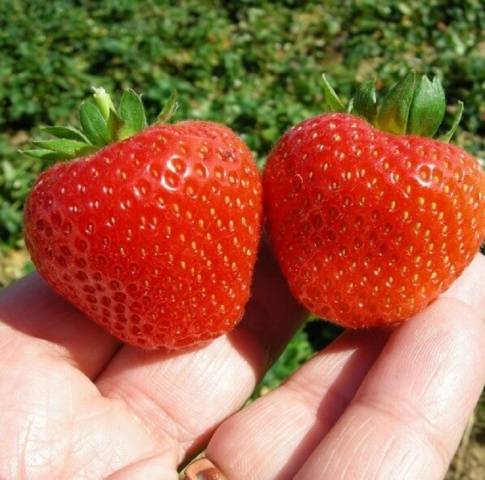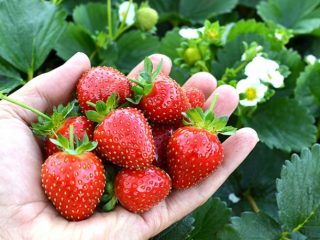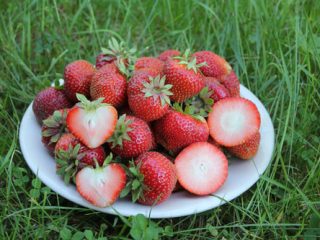Many gardeners, when growing strawberries, have favorite varieties. But it’s impossible to ignore the new products. One of these amazingly delicious beauties is the Portola strawberry.
The most important thing that gardeners need to know is the characteristics of the variety. "Portola" is a day-neutral remontant strawberry. What this means, novice gardeners can learn from the description of the Portola strawberries, photos and reviews of those who grow this variety.
Description of characteristics
Strawberries "Portola" are the result of the work of Californian breeders. The parent varieties were seedlings Cal 97.93-7 x Cal 97.209-1. Many people call the "Portola" strawberry variety an improved version of the famous "Albion", which it surpassed in its yield and taste. The fruits of "Portola" are formed on each inflorescence, so the yield of the variety is 35% higher than that of "Albion".
The main characteristics of Portola, which make the strawberry novelty very popular:
- Type of fruiting - repairable. Ordinary varieties produce a harvest for a relatively short time, maximum 2-3 weeks. But this is not enough for strawberry lovers. Therefore, they often choose remontant varieties that differ in the duration of fruiting. Strawberry remontant "Portola" lays fruit buds with daylight hours lasting 16-17 hours. This time is from late May to mid-July. Gardeners get their main harvest in the fall.
- Type of photoperiodic reaction – a day-neutral strawberry variety. This characteristic suggests that "Portola" lays fruit buds every 6 weeks. The length of daylight and temperature do not have much influence on this process, so the variety produces berries before frost. Fruiting is continuous; flowers, ripe and ripening berries are simultaneously located on one bush.
- Large fruit. Remontant strawberry This type pampers its owners with luxurious fruits, but requires more attention and care. It needs fertile soil, regular nutrition and watering, as well as enough space for development.
- Berries - the most basic characteristic for which gardeners make many sacrifices of their time and effort.
One strawberry of the “Portola” variety weighs about 35 g, has a surprisingly pleasant aroma and a sweet, harmonious taste. The core of the berries is homogeneous and elastic, so they are not afraid of transportation. The variety is transported and stored very well, which allows it to be grown for sale. When stored at 0.. +3°C, it does not lose its quality for three days. - Productivity is 1-2 kg per bush.
- It is necessary to mention one more advantage of the Portola variety of strawberries. Large-fruited elastic berries do not crunch while eating. Gardeners really like this feature. The shape of the berries is a wide cone, the color is red.
- Ripening period. In the description of the variety, the Portola strawberry is stated as a berry of medium late ripening. It begins to bear fruit in mid-June, in the middle zone a few days later.
Video report about the variety:
To make the description as complete as possible, we note some of the disadvantages of the Portola strawberries, which gardeners share in their reviews:
- Dependence of fruit sugar content on weather conditions.Decreases in cloudy weather.
- Shredding of berries without intensive feeding and strict compliance with agricultural technology requirements.
- Deterioration in taste and decrease in juiciness of berries during periods of extreme heat.
- Poor rooting of seedlings during elevated ambient temperatures.
- Susceptibility to spotting, chlorosis, and some viral and fungal infections.
Despite the reduction in fruit size, the remontant strawberry variety “Portola” retains its decorative value until late autumn. Many gardeners use this feature by immediately planting bushes in flower pots or flowerpots. It makes an excellent decoration for a balcony or gazebo.
Planting a remontant variety
Planting begins with preparing the site. For the Portola variety, you need to select a sunny place with fertile soil.
According to the description, the Portola strawberry prefers loam or sandy loam with a slightly acidic or neutral reaction. If the site has peaty or soddy-podzolic soil, then it is not suitable for the remontant variety. You need to either look for another place or import suitable soil.
Seedlings can be purchased at a specialized nursery. Another option is to propagate the variety yourself by dividing the bush or using a mustache.
You can plant "Portola" strawberry seedlings in spring or late summer (mid-August - late September). But in their reviews, gardeners are more inclined to plant Portola strawberries in the fall. If the bushes are planted in the spring, the harvest can be harvested the following year. And seedlings that successfully overwinter without the invasion of pests and diseases will begin to bear fruit in the summer.
The bed is prepared in advance.For spring planting, site preparation is done in the fall, for autumn planting - in the spring. In any case, dig up the soil with a pitchfork, remove plant debris and weeds, contribute per 1 sq. m organic matter (1 bucket) and wood ash (5 kg). A month before the target date, it is necessary to add 20 g of potassium sulfate and 40 g of superphosphate per 1 square meter to the soil. m area. You can replace both substances with 1 tbsp. spoon "Kaliyphos" onto the same area. The planting pattern for Portola strawberries is 80 cm x 40 cm; strawberries need enough space.
Strawberries are planted on a cloudy day. The holes are first watered, then the seedling is placed and the roots are carefully laid. It is important to ensure that they do not bend upward. After filling the hole with soil, the hearts should be above the soil surface. To prevent voids from forming between the roots, the soil around the bushes is compressed, the planted plants are watered and immediately mulched. Before winter, all the flowers that appear on the bush are picked off to ensure good fruiting next year.
Care
Basic care measures do not differ from those performed for ordinary strawberry varieties.
But, according to reviews and descriptions of the variety, the Portola strawberries require a lot of attention. If you ignore some points, the berries will be small and not sweet. It is important to remember that the variety does not tolerate temperature changes. Actions that gardeners need to prepare for from the beginning of the season:
Watering. If strawberries are grown on an industrial scale, then it will not be easy without drip irrigation. Therefore, strip irrigation is preferable.
Feeding. In early spring, the bushes are cleared of old leaves and fed with ammonium nitrate. Nitrogen feeding is repeated at the end of May.During the budding period, “Master” (balanced) or “Growth Concentrate” works well. When fruit sets, potassium nutrition is necessary.
Gardeners' recommendations for growing Portola strawberries:
- Remove the flower stalks of the first wave, then the second wave will be more powerful.
- The variety demonstrates good formation and fruiting only with intensive agricultural technology and favorable growing conditions.
- The peak yield of the variety coincides with the time of decline in fruiting in species of mid-early ripening. It would be optimal to combine such varieties on the site to ensure continuous fruiting.
- "Portola" is propagated by mustaches, dividing the bush and seeds. The last method is the most labor-intensive, but experienced gardeners often use it. This variety of strawberries produces little mustache.
- Be sure to mulch the beds. The variety requires watering, and this technique will help retain moisture longer.
In regions with cool climates, "Portola" grows very successfully in protected soil, even in a greenhouse:
The first harvest comes earlier and the berries have time to prepare for winter.
In the fall, it is necessary to cover the ridges so that the strawberries do not freeze. It is enough to lay a layer of straw or dry leaves.
"Portola" has good resistance to powdery mildew, crown rot, powder mold and wilt.. But measures must be taken against fruit rotting, spotting and leaf burns. To prevent fungal infection (spotting), you need to treat the area with Fitosporin in the spring. Treatment is carried out with copper oxychloride during the period of leaf growth, and again before flowering and after harvesting. You can replace the drug with Bordeaux mixture. It is important to keep the beds clean so that the bushes do not grow too large and are not overgrown with weeds.
Reviews
The description of the strawberry variety “Portola”, supplemented by reviews and photos of the plant, gives a complete picture of the acquaintance.















The berry is simply tasteless, even with proper care. Therefore, it is good for farmers producing for sale (yielding, beautiful, transportable) to grow on their own plot